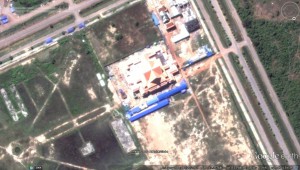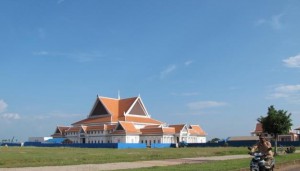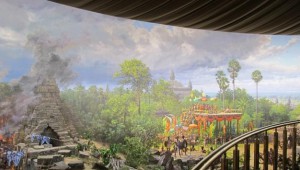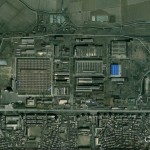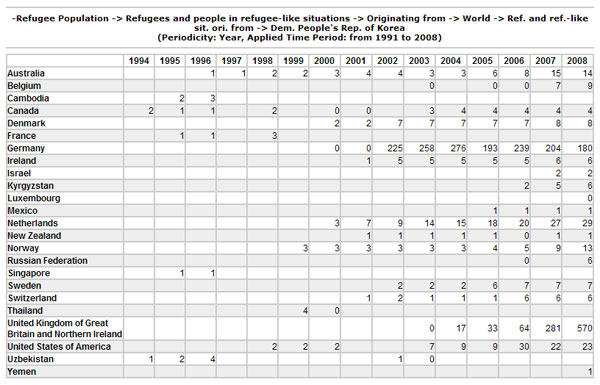Pictured Above (Google Earth, 2012-10-26): An image of the Angkor E-Museum under construction in Siem Reap Cambodia
UPDATE 7 (2016-2-1): The Guardian publishes more information on the museum.
UPDATE 6 (2015-12-6): The museum opens! According to the Khmer Times:
After five years of building and delays, the $24 million Angkor Panorama Museum in Siem Reap was opened on Friday by Deputy Prime Minister Sok An, cementing growing ties between the Kingdom and North Korea, especially in Siem Reap.
Mr. Sok An said the 6,000 square meter building reinforced both cultural and economic ties.
The project was signed in 2011, under which North Korea’s Mansudea Overseas Project Group will run the museum with the government under a build-operate-and-transfer operation for 10 years until it is handed over to the Apsara Authority.
In the meantime, profits will be split evenly.
“We did not sell this land. We have a joint committee and we studied the investment project on all fronts before the government approved it. We treat foreign investment equally,” said Mr. Sok An.
“We need more tourist products such as this to attract visitors to Cambodia. The museum… is another tourism attraction that features, through the painting [mural] inside the museum, how our Khmer ancestors went about their daily activities during Angkorian time,” he said at the opening ceremony attended by an estimated 1,000 people, including South and North Koreans.
The project caused concern with South Korea, fearing it could be used for propaganda in the province, which is the country’s biggest tourist attraction. The Angkor Wat temple complex was listed for protection by the UN cultural organization UNESCO in 1992.
The new museumincludes work from 63 North Korean artists.
North Korean ambassador Hong Ki Chol told the crowd: “It was well built in a picturesque place, surrounded by Angkor temples – the pride of Khmers. We are proud that this museum was built to show Cambodian culture in the prestigious era of Angkor.”
“I am confident the museum will make a positive contribution to giving a comprehensive understanding of ideas about all the Angkor temples and promote tourism,” he said.
Cambodia received 4.5 million tourists last year, a 20 percent increase on the previous year and accounting for about 16 percent of the country’s gross domestic product. The Kingdom is targeting 8 million tourists by 2020.
“We want to see tourists stay longer in Cambodia,” said Mr. Sok An, who is also chairman of the Apsara Authority. ”The longer they stay, the more it benefits our people and the economy.”
UPDATE 5 (2014-6-14): The museum is still not open. According to an article in the Phnom Penh Post:
Siem Reap is home to North Korea’s first overseas museum, a $15 million tribute to Angkor set in a Khmer-style building which is not yet open to the public.
…
Although construction began in August 2011, the doors have still not opened and the car park has not been built.
The operations manager, who gave his name only as Kim, said the museum would open in three or four months, and blamed the delay on the unfinished car park and ticketing booth.
But sources within the South Korean community say the slow progress is due to the plan to build an information centre about the temples, which has caused a rift with the Apsara authority, which manages the complex.
UPDATE 4 (2104-1-20): It is January 2014, and the Museum still has not opened. A recent visitor, however, offers images of the museum and some details. According to the article:
The Grand Panorama Museum is a gift to cement the “glorious friendship between Korea and Cambodia”, says a young translator from Pyongyang, capital of the hermit state.
…
The building site is still strictly off-limits as I visit but, despite the secrecy, the man in charge relents and provides a short tour.
The museum is right next to the new ticket booths for the temple complex. The avowed aim is to take visitors back to the heyday of Khmer culture, which flourished in Angkor between the 12th and 15th centuries.
The museum’s interpretation is not so much scholarly as glitzy, with otherworldly music and coloured lights. It also showcases the North Korean style of ultra-realist painting. A huge face of the Buddha looms at the entrance.
“A true-scale copy of the stone-hewn figures at the Bayon Temple,” says the building chief. The giant painting looks remarkably like a photograph. “Exactly,” beams the official. “But it’s not a photograph – it’s Korean art.”
The big Buddha is a product of the Mansudae art factory in Pyongyang, which employs a thousand artists turning out paintings in oil, acrylic and watercolours in the “social realist” style. Abstraction is not allowed.
The panorama is viewed from a platform in the centre of a circular room. The entire wall is a single vast picture, 13 metres tall and 130 long. It depicts the many temples and everyday scenes from the 12th-century Khmer era – or at least daily life as imagined by North Korean artists.
The official word is that all the scenes were painted “following consultations with Cambodian historians”, the site supervisor is anxious to point out. The finished product is strong on battles, with lots of bloodshed.
“We have a panoramic museum like this in Pyongyang too,” says the supervisor. Is it about ancient Korean history? “No, it’s about the Americans’ war.”
The illusion of being at the centre of the Khmer empire is extended by all manner of fake walls, cannons and plastic trees between the raised platform and the panorama wall. The models carefully match the objects visible in the painted panorama.
“We will have wind and fog-making machines so that the trees will rustle,” says the young translator.
The museum also offers scale models of the sprawling temple complex and a 3D theatre where films depicting temple construction will be screened.
North Korean art is on sale in the foyer, along with cute souvenir dolls dressed in what the North Koreans say is the authentic Khmer national costume.
One huge oil painting in the shop is definitely not for sale. It depicts a snow-covered landscape in Korea’s mountains with a little hut in the foreground highlighted by a shaft of sunlight.
“That is the birthplace of our Great Leader,” the supervisor says reverently. “The picture is here on loan.” The late North Korean founding father Kim Il-sung is revered like a god.
The article offers some pictures as well:
UPDATE 3 (2013-1-8): NK News explains some of the features the museum will contain and reports that it will open in April 2013.
UPDATE 2 (2011-11-26): Accoridng to AKP (Cambodia):
Cambodia has allowed the Democratic People’s Republic of Korea to build a cultural information centre (or welcome centre) in Siem Reap, the home of Angkor, as part of the government’s effort to attract more tourists, according to the Press and Quick Reaction Unit of the Council of Ministers.
In a meeting on Thursday, Deputy Prime Minister H.E. Dr. Sok An told the North Korean Ambassador H.E. Ri In Sok that Cambodia’s Apsara Authority is working with North Korean experts to build the centre, which will serve as a welcome centre for tourists who want information about Cambodia’s Angkorian history.
Officials of the Apsara Authority for the Protection and Management of Angkor and the Region of Siem Reap are working with 60 Korean experts and concerned institutions to ensure that the building design will feature the cultural values of both Cambodia and Korea.
The building, 70 metres in diameter and 124 metres in height, will be decorated with artistic works and drawings. Korean officials say that the world’s biggest artistic drawing will be displayed at the centre.
Dr. Sok An, who is also Minister in Charge of the Office of the Council of Ministers, told the ambassador that the centre will represent not only the image of the Democratic People’s Republic of Korea but also the good bilateral relations of the two Asian nations.
The outgoing North Korean Ambassador Ri In Sok, who is leaving Cambodia on Nov. 26 after a four-year term, told Dr. Sok An that North Korea wants unification with South Korea as soon as possible.
The ambassador was grateful to the deputy prime minister and the Royal Government of Cambodia as a whole for facilitating his diplomatic mission in Cambodia.
“I am pleased with the bilateral cooperation. I am pleased with the tremendous progress made by Cambodia over the past years,” said Ambassador Ri In Sok in the meeting.
The ambassador said the Democratic People’s Republic of Korea continues its good relations with the Royal Government of Cambodia thanks to the diplomatic legacy of the relations between His Majesty King Norodom Sihanouk, now retired, and the late Kim Il-Sung, leader of the Democratic People’s Republic of Korea.
Additional information:
1. Voice of America also picked up this story
2. NK Leadership Watch also covered the story.
3. The Mansudae Overseas Development Group (MODG) is also building/has already built an e-museum in Siem REap. Learn more here.
4. Here are previous posts on the DPRK and Cambodia.
UPDATE 1 (2011-8-3): Construction is underway on the project. According to the Global Post:
A wall of royal blue sheet metal obscures the North Koreans’ operation from public view. When I approached the entrance, a man in a fedora and a tank top rushed over to slam the gate shut. A furtive look inside revealed fewer than a dozen scrawny workers and a scrub grass field still void of much construction.
Though local reports vary, North Korea will be paid between $10 and $17 million for some sort of monument or museum near the temples. The head of Cambodia’s culture ministry, Khem Sarith, confirmed construction of an “e-museum” but could not confirm the cost.
Nor could he explain why a country that offers its citizens scant electricity should win an “electronic museum” contract, especially after its monuments abroad have drawn both condemnation and ridicule.
The full story is well worth reading here:
North Korea propaganda unit builds monuments abroad
Global Post
Patrick Winn
2011-8-3
ORIGINAL POST (2010-4-27): According to the AFP (Via the Straits Times in Singapore):
A controlversial North Korean construction company is in talks to build an ‘e-museum’ of Cambodia’s famed Angkor temples, a senior official said on Monday.
Mansudae Overseas Projects wants to build a museum close to the temple complex that will feature a computer-generated simulation of the ancient monuments, Cambodian Culture Ministry secretary of state Khem Sarith told AFP.
‘They have plans to build an electronic museum detailing the history of Angkor Wat temples,’ he said, adding he supported the plans after discussions last week with a company delegation and North Korean ambassador Ri In Sok.
Previous work by the North Korean company building major monuments in African countries has been criticised for lack of transparency. Its 49-metre bronze Monument for the African Renaissance has caused outrage in Senegal over the sale of government land to finance the project and the president’s plan to keep 35 per cent of any profit it generates.
Mr Khem Sarith said the so-called e-museum would be ‘good for tourists to view the temples and then select the one that they want to see’. Studies and more discussion were still needed before construction could start on the digitally-rendered overview, Khem Sarith said. He said he would meet again with officials from the company in June to discuss the project further.
The 12th century Angkor Wat temple complex is Cambodia’s main tourist attraction. It is located in the northwestern province of Siem Reap, where the ancient Khmer empire built some 1,000 temples spread over 160 square kilometres.
I have pretty extensive list of Mansudae Overseas Development Group projects from across the planet. If you are aware of a North Korean built project in your country, please let me know.
(Thanks to a reader)
Read the full story here:
‘e-museum’ of Angkor temples
AFP (Straits Times)
4/26/2010
John Cosgrove
